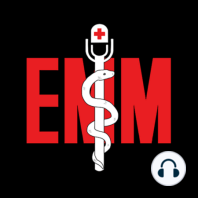2 min listen

Podcast 553: Airway Management in the Hypoxic COVID-19 Patient (Recorded 4/3/20)
Podcast 553: Airway Management in the Hypoxic COVID-19 Patient (Recorded 4/3/20)
ratings:
Length:
9 minutes
Released:
Apr 6, 2020
Format:
Podcast episode
Description
Contributor: Dylan Luyten, MD Educational pearls: Clinical management of COVID-19 is rapidly evolving, relying on case reports and clinical experience In just a month, the consensus around management of COVID patients with severe hypoxia has shifted from an early intubation strategy to other, non-invasive means Intubating early can quickly consume ventilator resources, require increased intensive care monitoring, and likely leads to longer hospital stays and once COVID patients are intubated, extubation can take days to weeks. In Italy, ventilator supplies were depleted leading to the use of helmet CPAP machines, which appeared to be effective in management of respiratory distress in COVID, though not available for use in the US Non-invasive ventilation such as CPAP/BiPAP is thought to increase risk to staff for infection via aerosolization, and has often been avoided in COVID patients High flow nasal cannulas appear to pose less of a risk of aerosolization of viral particles (especially when a surgical mask is placed over the patient’s nose, mouth and apparatus) Anecdotal evidence from NYC has shown success allowing conscious patients to maintain hypoxia on HFN, where they will self prone to help with lung recruitment, and seemingly do well despite persistent saturations in the 80s or less Hospitals around the country are moving away from the intubate early methodology in favor of high flow oxygen therapy as long as they are not having issues with work of breathing or other complications The pathophysiology of respiratory distress and hypoxia in COVID patients is evolving as well, and some presentations appear similar to disease processes such as high altitude pulmonary edema (HAPE) rather than acute respiratory distress syndrome (ARDS), in that patients are quite well appearing despite phenomenally low oximetry readings. These select patients appear to be excellent candidates for non-invasive means rather than an early intubation strategy Editor’s note: do not take lightly that intubation is one of the highest risk aerosolization generating procedures, along with many peri-intubation procedures like suctioning, BVM, etc. References [1]. Sorbello, M. et al. The Italian coronavirus disease 2019 outbreak: recommendations from clinical practice. Anaesthesia. 2020 Mar 27. [2]. Giwa, AL. Desai A. Duca A. Novel 2019 coronavirus SARS-CoV-2 (COVID-19): An updated overview for emergency clinicians. Emerg Med Pract. 2020 May 1;22(5):1-28. [3]. Ather B, Edemekong PF. Airborne Precautions. [Updated 2020 Feb 17]. In: StatPearls [Internet]. Treasure Island (FL): StatPearls Publishing; 2020 Jan. Summarized by Jackson Roos, MS3 | Edited by Erik Verzemnieks, MD Photo Credit: New England Journal of Medicine https://www.nejm.org/doi/full/10.1056/NEJMc2007589?query=RP
Released:
Apr 6, 2020
Format:
Podcast episode
Titles in the series (100)
REBOA: Introduction of the use of REBOA for hemorrhagic shock. by Emergency Medical Minute